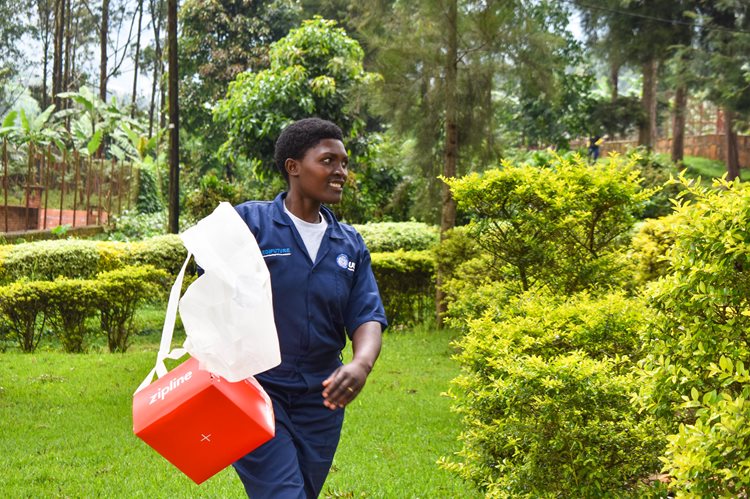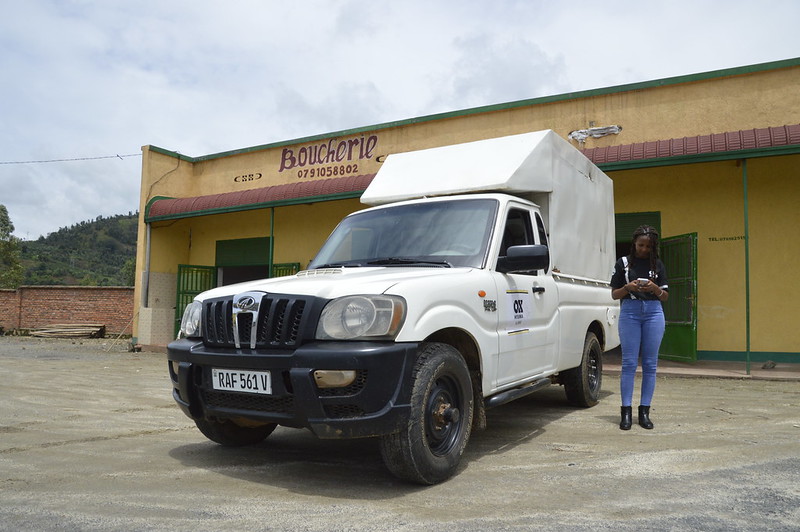From MSD Hub: The Symbiosis of Efficient Last-Mile Distribution and Community Engagement
To address last-mile delivery constraints, community-level organizing must be considered in tandem with private sector investments.
Banner image: A Zipline operator performs quality checks on a drone before takeoff.
This story was originally published on MSD Hub.
Long before the war in Ukraine disrupted global supply chains causing prices of grain, oil, and natural gas to skyrocket, smallholder farmers in remote areas of Rwanda had limited access to agricultural inputs and markets. Livestock production in Rwanda is hampered by poor access to quality animal feeds, improved animal genetics, and other key inputs due to unstructured demand from rural smallholder producers and limited commercial incentives for feed supply chain actors to serve rural markets and farmers. Laying the foundation to address last mile constraints should ideally combine community-level aggregation and organizing, de-risking private sector investments, and strong cooperation and information between the two. This is important since even the best innovation or biggest investment will fail without community buy-in/organizing.
The Feed the Future Rwanda Orora Wihaze Activity — a five-year livestock market systems activity — co-created an innovative last-mile model with private sector actors to address supply chain constraints related to smallholder access to animal feed and improved pig genetics. Orora Wihaze partnered with a logistics company, OX Delivers, to leverage their last-mile logistics expertise for transporting animal feed — aiming to scale up affordable, eco-friendly transportation. OX’s digital platform enables remote agro-dealers to place orders by text message, allowing more efficient aggregation of deliveries to traditionally underserved rural areas. Producers have also used the same trucks to deliver their products to urban markets at a lower price.

An artificial insemination (A.I.) technician collects a drone delivery containing a pig breeding kit.
In an effort to bring improved pig genetics to remote smallholders, Orora Wihaze, Vétérinaires Sans Frontières (VSF), and the Rwanda Agriculture and Animal Resources Development Board (RAB) engaged California-based technology firm Zipline Inc. to send drones with artificial insemination packages to pig farmers, who were struggling to access good quality breeding stock. Their pig breeds produced poor quality pork products and sows struggled to reproduce — typically only birthing four piglets per litter. Whereas a normal trip from RAB’s pig breeding center in Muhanga to a smallholder pig farmer in Gakenke takes three and a half hours without traffic, this innovation has trimmed delivery times to an average of 20 minutes for the same delivery by drone, cutting cost savings nearly in half, and increasing breeding services. The study also revealed the time-sensitive nature of pig semen delivery and the implication of late delivery.
Rapid learning assessments of both co-investments carried out one year after launching each initiative were insightful. Ox’s platform allowed agro-dealers to place orders via text message or free hotline and strengthened the relationship with distributors and feed manufacturers. As a result, two feed millers now use OX to distribute their products to remote agro-dealers, a market that manufacturers previously viewed as unprofitable. The assessment found that 79 percent of interviewed agro-dealers had returning customers; they increased their sales by 43 percent; and 69 percent of their customers had increased their production as a result of being able to access quality feed. For the 184 producers who benefitted from artificial insemination of improved pig breeds, 70 percent of producers had increased their production.
However, in both examples, the number of women who benefitted from using animal feed or improved pig breeds were 20 percent and 8 percent, respectively. In addition, there remains a significant gap in the number of trained technicians who can perform A.I to meet increasing demand. Also, the price of animal feed is higher than many can afford, largely a result of global commodity price trends.

A manager with the OX logistics team stands outside a truck loaded with animal feed at their depot in Nyamasheke.
On the surface, it appears that a technology solution solved specific last mile supply chain constraints. However, the initial success is linked to an important change agent – community animal health workers. Since 2020, Orora Wihaze supported a network of community animal health workers linked to the Rwanda Council of Veterinary Doctors (RCVD) and Imbaraga Farmers Association who have been supporting livestock producers. They have been important mobilizers in spreading the message about the benefits of improved pig genetics and usage of improved animal feed, aggregating smallholder demand and introducing new logistics players such as Ox, Zipline, and a new supply chain second mover – Ironji – to agro-dealers in remote rural areas. The flow of information is considered an important sign of a healthy market system, and the new role that community animal health workers are playing to amplify information about animal feed to producers, and disseminate market demand information about producers to distributors is a linchpin to this now functioning sub-system. They have collectively disrupted the prevailing impression that there are no opportunities in rural areas. In a new phase of each activity, Orora Wihaze is supporting these partners to increase outreach to women and youth livestock producers, expand to new districts, introduce new business models, and expand the network of trained technicians to perform AI.
View the original story on MSD Hub.